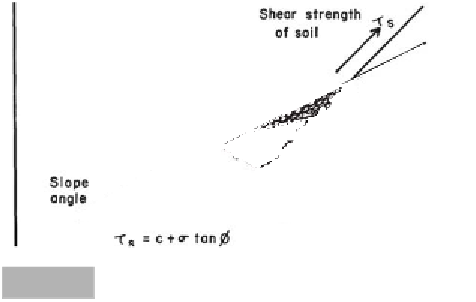Geoscience Reference
In-Depth Information
s
=
c
+ (
-
) tan
(12.6)
Shear strength of soil
where
= pore-water pressure
In this case,
normal stress
is reduced by the pore-
water pressure Í. If overburden is added to a soil, it
will immediately increase pore-water pressure. Unless
the excess pore-water pressure is reduced through
drainage of water, the critical stress on that soil will
exceed the critical resistance of the soil, causing slope
failure. If, on the other hand, wet material is added
upslope, there is no change in the stress being applied
to the soil. However, the water in this material can
drain into the soil downslope, increasing progressively
over time its pore-water pressure. Failure of the slope
may happen sometime after the overburden was
emplaced upslope. A slope that has been stable under
existing load and watertable conditions can also
become unstable if drainage patterns are changed in
the surrounding area. Dams raise watertables locally -
a fact that may cause subsequent slope failure in
adjacent areas some time after the dam is filled.
Construction of buildings on slopes with septic systems
can also increase the pore-water pressure, leading to
subsequent failure. The source of water need not come
solely from septic tanks. It could also come from lawn
watering and other domestic discharges.
Earthquakes can increase the pore-water pressure
of a soil with each passage of a compression shock
wave. As the pore-water pressure increases, it may
not be reduced fast enough by discharge of water
from the ground before the next compression wave
sweeps past. The effective stress in the material thus
decreases with each shock wave until the pore-water
pressure is equal to the normal stress in the soil
(Figure 10.9). At this point liquefaction will result. In
unconsolidated sediment, the smaller the particle size,
the more water movement is inhibited because of
capillary cohesion. Very fine silt and clays thus should
be susceptible to liquefaction during earthquakes.
However, depending upon the degree of consoli-
dation, weathering, or other factors, cohesion in these
materials may exceed the increases in pore-water
pressure during the passage of earthquake shock
waves. Thus, liquefaction tends to occur best in
medium- to fine-grained sands that have not com-
pletely compacted. Because these types of sediments
are widespread, especially in marine environments or
on river floodplains, liquefaction is an almost universal
feature of moderate-to-large earthquakes.
Possible angle
of internal friction
Slope
angle
Normal stress
σ
α
Schematic representation of the Mohr-Coulomb equation.
Note that the angle
Fig. 12.3
is not necessarily the slope angle,
but the angle of internal friction within the slope mass.
unconsolidated material. Loosely compacted material
tends to have a lower angle of shearing resistance than
very compressed or compacted material. All unconsoli-
dated material tends to fail at internal angles less than
the slope angle upon which it is resting. The Mohr-
Coulomb equation can also be used to define the
shear
strength
of a unit of rock resting on a failure plane and
the susceptibility of that material to landslides. In this
case, the formula must be modified to include the
characteristics of bedding planes. If the stress applied
to the soil exceeds the shear strength, then the material
will fail and begin to move downslope.
Pore
-water pressure
Almost all material, no matter what its state of consoli-
dation, contains pores or voids, which may be filled with
air or, more often, water. If the water does not adhere
solely to individual particles as capillary water, but
completely fills voids forming a watertable, then it will
flow freely under a pressure head. If the soil is incom-
pressible, a rise in the watertable will cause the pressure
of water in voids at depth to increase. Furthermore,
some of the added pressure may be taken up by the
grain-to-grain contacts in the soil. If an external load is
applied to a soil mass on a slope in the form of additional
water, or overburden, then the pore-water pressure will
build up in that mass and water will be expelled at weak
points. These weak points occur along fracture lines,
bedding planes, or at the base of the regolith, where
pore-water pressure is highest. As water drains from a
soil body, the pore-water pressure will decrease.
The increase in pore-water pressure in the
Mohr-Coulomb equation reduces the effective resis-
tance of the soil body or regolith as shown by the
following equation:





































